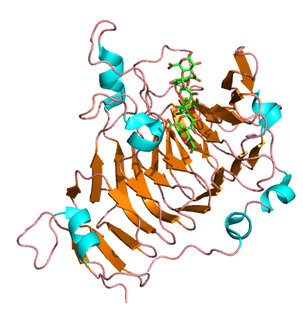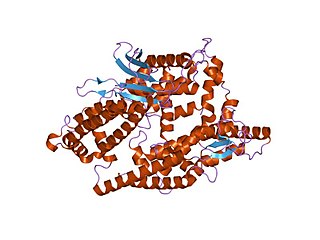Related Research Articles

A protease is an enzyme that catalyzes proteolysis, the breakdown of proteins into smaller polypeptides or single amino acids. They do this by cleaving the peptide bonds within proteins by hydrolysis, a reaction where water breaks bonds. Proteases are involved in many biological functions, including digestion of ingested proteins, protein catabolism, and cell signaling.

Glutamate dehydrogenase is an enzyme observed in both prokaryotes and eukaryotic mitochondria. The aforementioned reaction also yields ammonia, which in eukaryotes is canonically processed as a substrate in the urea cycle. Typically, the α-ketoglutarate to glutamate reaction does not occur in mammals, as glutamate dehydrogenase equilibrium favours the production of ammonia and α-ketoglutarate. Glutamate dehydrogenase also has a very low affinity for ammonia, and therefore toxic levels of ammonia would have to be present in the body for the reverse reaction to proceed. However, in brain, the NAD+/NADH ratio in brain mitochondria encourages oxidative deamination. In bacteria, the ammonia is assimilated to amino acids via glutamate and aminotransferases. In plants, the enzyme can work in either direction depending on environment and stress. Transgenic plants expressing microbial GLDHs are improved in tolerance to herbicide, water deficit, and pathogen infections. They are more nutritionally valuable.

In cell biology, a phagosome is a vesicle formed around a particle engulfed by a phagocyte via phagocytosis. Professional phagocytes include macrophages, neutrophils, and dendritic cells (DCs). A phagosome is formed by the fusion of the cell membrane around a microorganism, a senescent cell or an apoptotic cell. Phagosomes have membrane-bound proteins to recruit and fuse with lysosomes to form mature phagolysosomes. The lysosomes contain hydrolytic enzymes and reactive oxygen species (ROS) which kill and digest the pathogens. Phagosomes can also form in non-professional phagocytes, but they can only engulf a smaller range of particles, and do not contain ROS. The useful materials from the digested particles are moved into the cytosol, and waste is removed by exocytosis. Phagosome formation is crucial for tissue homeostasis and both innate and adaptive host defense against pathogens.

A leucine zipper is a common three-dimensional structural motif in proteins. They were first described by Landschulz and collaborators in 1988 when they found that an enhancer binding protein had a very characteristic 30-amino acid segment and the display of these amino acid sequences on an idealized alpha helix revealed a periodic repetition of leucine residues at every seventh position over a distance covering eight helical turns. The polypeptide segments containing these periodic arrays of leucine residues were proposed to exist in an alpha-helical conformation and the leucine side chains from one alpha helix interdigitate with those from the alpha helix of a second polypeptide, facilitating dimerization.

A branched-chain amino acid (BCAA) is an amino acid having an aliphatic side-chain with a branch. Among the proteinogenic amino acids, there are three BCAAs: leucine, isoleucine, and valine. Non-proteinogenic BCAAs include 2-aminoisobutyric acid.
A DNA-binding domain (DBD) is an independently folded protein domain that contains at least one structural motif that recognizes double- or single-stranded DNA. A DBD can recognize a specific DNA sequence or have a general affinity to DNA. Some DNA-binding domains may also include nucleic acids in their folded structure.

A leucine-rich repeat (LRR) is a protein structural motif that forms an α/β horseshoe fold. It is composed of repeating 20–30 amino acid stretches that are unusually rich in the hydrophobic amino acid leucine. These tandem repeats commonly fold together to form a solenoid protein domain, termed leucine-rich repeat domain. Typically, each repeat unit has beta strand-turn-alpha helix structure, and the assembled domain, composed of many such repeats, has a horseshoe shape with an interior parallel beta sheet and an exterior array of helices. One face of the beta sheet and one side of the helix array are exposed to solvent and are therefore dominated by hydrophilic residues. The region between the helices and sheets is the protein's hydrophobic core and is tightly sterically packed with leucine residues.

In biology, a phagolysosome, or endolysosome, is a cytoplasmic body formed by the fusion of a phagosome with a lysosome in a process that occurs during phagocytosis. Formation of phagolysosomes is essential for the intracellular destruction of microorganisms and pathogens. It takes place when the phagosome's and lysosome's membranes 'collide', at which point the lysosomal contents—including hydrolytic enzymes—are discharged into the phagosome in an explosive manner and digest the particles that the phagosome had ingested. Some products of the digestion are useful materials and are moved into the cytoplasm; others are exported by exocytosis.

Pectinesterase (PE) is a ubiquitous cell-wall-associated enzyme that presents several isoforms that facilitate plant cell wall modification and subsequent breakdown. It is found in all higher plants as well as in some bacteria and fungi. Pectinesterase functions primarily by altering the localised pH of the cell wall resulting in alterations in cell wall integrity.

The Pathogen-Host Interactions database (PHI-base) is a biological database that contains curated information on genes experimentally proven to affect the outcome of pathogen-host interactions. The database is maintained by researchers at Rothamsted Research, together with external collaborators since 2005. Since April 2017 PHI-base is part of ELIXIR, the European life-science infrastructure for biological information via its ELIXIR-UK node.
The gene-for-gene relationship was discovered by Harold Henry Flor who was working with rust of flax. Flor showed that the inheritance of both resistance in the host and parasite ability to cause disease is controlled by pairs of matching genes. One is a plant gene called the resistance (R) gene. The other is a parasite gene called the avirulence (Avr) gene. Plants producing a specific R gene product are resistant towards a pathogen that produces the corresponding Avr gene product. Gene-for-gene relationships are a widespread and very important aspect of plant disease resistance. Another example can be seen with Lactuca serriola versus Bremia lactucae.

The acetolactate synthase (ALS) enzyme is a protein found in plants and micro-organisms. ALS catalyzes the first step in the synthesis of the branched-chain amino acids.

Leucyl aminopeptidases are enzymes that preferentially catalyze the hydrolysis of leucine residues at the N-terminus of peptides and proteins. Other N-terminal residues can also be cleaved, however. LAPs have been found across superkingdoms. Identified LAPs include human LAP, bovine lens LAP, porcine LAP, Escherichia coli LAP, and the solanaceous-specific acidic LAP (LAP-A) in tomato.

In enzymology, a sterol 14-demethylase (EC 1.14.13.70) is an enzyme that catalyzes the chemical reaction

A cutinase (EC 3.1.1.74) is an enzyme that catalyzes the chemical reaction
Resistance genes (R-Genes) are genes in plant genomes that convey plant disease resistance against pathogens by producing R proteins. The main class of R-genes consist of a nucleotide binding domain (NB) and a leucine rich repeat (LRR) domain(s) and are often referred to as (NB-LRR) R-genes or NLRs. Generally, the NB domain binds either ATP/ADP or GTP/GDP. The LRR domain is often involved in protein-protein interactions as well as ligand binding. NB-LRR R-genes can be further subdivided into toll interleukin 1 receptor (TIR-NB-LRR) and coiled-coil (CC-NB-LRR).

Plant disease resistance protects plants from pathogens in two ways: by pre-formed structures and chemicals, and by infection-induced responses of the immune system. Relative to a susceptible plant, disease resistance is the reduction of pathogen growth on or in the plant, while the term disease tolerance describes plants that exhibit little disease damage despite substantial pathogen levels. Disease outcome is determined by the three-way interaction of the pathogen, the plant and the environmental conditions.

Polygalacturonase, also known as pectin depolymerase, PG, pectolase, pectin hydrolase, and poly-alpha-1,4-galacturonide glycanohydrolase, is an enzyme that hydrolyzes the alpha-1,4 glycosidic bonds between galacturonic acid residues. Polygalacturonan, whose major component is galacturonic acid, is a significant carbohydrate component of the pectin network that comprises plant cell walls. Therefore, the activity of the endogenous plant PGs works to soften and sweeten fruit during the ripening process. Similarly, phytopathogens use PGs as a means to weaken the pectin network, so that digestive enzymes can be excreted into the plant host to acquire nutrients.

Leucine-rich repeat receptor like protein kinase are plant cell membrane localized Leucine-rich repeat (LRR) receptor kinase that play critical roles in plant innate immunity. Plants have evolved intricate immunity mechanism to combat against pathogen infection by recognizing Pathogen Associated Molecular Patterns (PAMP) and endogenous Damage Associated Molecular Patterns (DAMP). PEPR 1 considered as the first known DAMP receptor of Arabidopsis.

Thimet oligopeptidases, also known as TOPs, are a type of M3 metallopeptidases. These enzymes can be found in animals and plants, showing distinctive functions. In animals and humans, they are involved in the degradation of peptides, such as bradykinin, neurotensin, angiotensin I, and Aβ peptide, helping to regulate physiological processes. In plants, their role is related to the degradation of targeting peptides and the immune response to pathogens through Salicylic Acid (SA)-dependent stress signaling. In Arabidopsis thaliana—recognized as a model plant for scientific studies—two thimet oligopeptidases, known as TOP1 and TOP2, have been identified as targets for salicylic acid binding in the plant. These TOP enzymes are key components to understand the SA-mediated signaling where interactions exist with different components and most of the pathways are unknown.
References
- ↑ Darvill, A., Bergmann, C., Cervone, F., De Lorenzo, G., Ham, K.-S., Spiro, M. D., York, W. S., and Albersheim, P. (1994) Oligosaccharins involved in plant growth and host-pathogen interactions, Biochem. Soc. Symp. 60, 89-94.
- ↑ Jones, T. M., Anderson, A. J., and Albersheim, P. (1972) Hostpathogen interactions IV, Studies on the polysaccharide-degrading enzymes secreted by Fusarium oxysporum f. sp. lycopersici, Physiol. Plant Pathol. 2, 153-166.
- ↑ Cook, B. J., Clay, R. P., Bergmann, C. W., Albersheim, P., and Darvill, A. G. (1999) Fungal polygalacturonases exhibit different substrate degradation patterns and differ in their susceptibilities to polygalaturonase inhibiting proteins, Mol. Plant-Microbe Interact. 12, 703-711.
- ↑ Federici L, Caprari C, Mattei B, Savino C, Di Matteo A, De Lorenzo G, Cervone F, Tsernoglou D. Structural requirements of endopolygalacturonase for the interaction with PGIP (polygalacturonase-inhibiting protein). Proc Natl Acad Sci U S A. 2001 Nov 6;98(23):13425-30.
- ↑ Daniel King, Carl Bergmann, Ron Orlando, Jacques A. E. Benen, Harry C. M. Kester, and Jaap Visser; “Use of Amide Exchange Mass Spectrometry To Study Conformational Changes within the Endopolygalacturonase II – Polygalacturonic Acid – Polygalacturonase Inhibiting Protein System”, Biochem. 41, 10225-10233, 2002.
- ↑ Hahn, M. G., Bucheli, P., Cervone, F., Doares, S. H., O’Neill, R. A., Darvill, A., and Albersheim, P. (1989) The Roles of Cell Wall Constituents in Plant-Pathogen Interactions, in Plant-Microbe Interactions. Molecular and Genetic PerspectiVes (Kosuge, T., and Nester, E. W., Eds.) Vol. 3, pp 131-181, McGraw-Hill, New York.
- ↑ Cervone, F., De Lorenzo, G., Salvi, G., Bergmann, C., Hahn, M. G., Ito, Y., Darvill, A., and Albersheim, P. (1989) Release of Phytoalexin Elicitor-Active Oligogalacturonides by Microbial Pectic Enzymes, in Signal Molecules in Plants and Plant-Microbe Interactions (Lugtenberg, B. J. J., Ed.) NATO ASI Series, Vol. H36, pp 85-89, Springer-Verlag, Heidelberg, Germany.
- ↑ Stotz, H. U., Bishop, J. G., Bergmann, C. W., Koch, M., Albersheim, P., Darvill, A. G., and Labavitch, J. M. (2000) Identification of target amino acids that affect interactions of fungal polygalacturonases and their plant inhibitors, Physiol. Mol. Plant Pathol. 56, 117-130.
- ↑ Leckie, F., Mattei, B., Capodicasa, C., Hemmings, A., Nuss, L., Aracri, B., De Lorenzo, G., and Cervone, F. (1999) The specificity of polygalacturonase-inhibiting protein (PGIP): a single amino acid substitution in the solvent-exposed â-strand/â-turn region of the leucine-rich repeats (LRRs) confers a new recognition capability, EMBO J. 18, 2352-2363.
- ↑ A. Di Matteo, L. Federici, B. Mattei, G. Salvi, K.A. Johnson, C. Savino, G. De Lorenzo, D. Tsernoglou, F. Cervone, “The Crystal Structure of Polygalacturonase-Inhibiting Protein (Pgip), A Leucine-Rich Repeat Protein Involved in Plant Defense”. Proc. Natl. Acad. Sci. USA, 100, 10124, 2003
- ↑ Jae-Min Lim, Kazuhiro Aoki, Peggi Angel, Derek Garrison, Daniel King, Michael Tiemeyer, Carl Bergmann, and Lance Wells, “Mapping Glycans onto Specific N-Linked Glycosylation Sites of Pyrus Communis PGIP Redefines the Interface for EPG:PGIP Interactions”, Journal of Proteome Research, 8, 673-680, 2009
- ↑ PG & PGIP Structural Database, http://www.pg-pgip.info